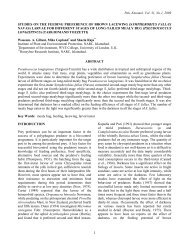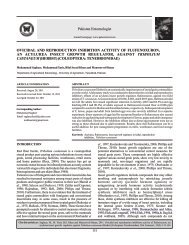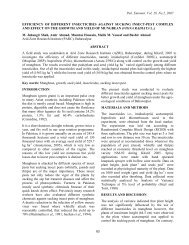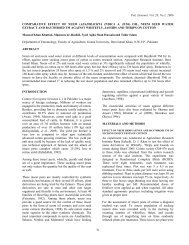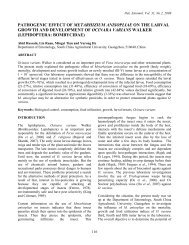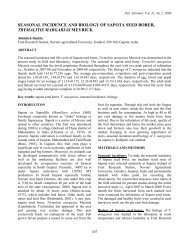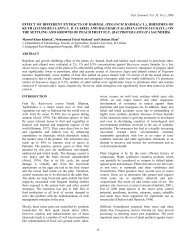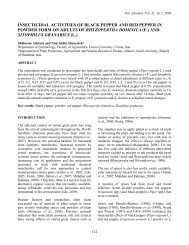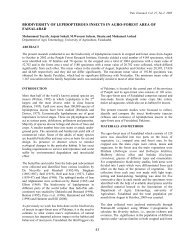SOME STUDIES ON THE TOXICITY OF CONVENTIONAL AND ...
SOME STUDIES ON THE TOXICITY OF CONVENTIONAL AND ...
SOME STUDIES ON THE TOXICITY OF CONVENTIONAL AND ...
You also want an ePaper? Increase the reach of your titles
YUMPU automatically turns print PDFs into web optimized ePapers that Google loves.
Galleria mellonella were collected in a new vial and the<br />
females of B. hebetor were given healthy larvae of G.<br />
mellonella for further parasitization.<br />
B. Rearing of greater wax moth Galleria mellonella:<br />
Adults were kept in plastic jars (diameter, 5cm and depth<br />
30cm) along with cotton soaked with 20-30% honey<br />
solution to feed. Folded paper sheets were put in jars for<br />
egg laying. The paper sheets with eggs were transferred<br />
to the artificial diet (crushed wheat, bees wax, dates juice,<br />
yeast, and glycerin). The jars were placed in a growth<br />
chamber at 30 ±1°C and 65 ± 5 % r.h. until adult<br />
emergence.<br />
C. Bioassay:<br />
For bioassay study, the residual vials method was used.<br />
The commercial formulations of chlorpyrifos, profenofos,<br />
lufenuron, emamectin benzoate and methoxyfenozide<br />
were obtained from the local market. The concentrations<br />
of different insecticides were prepared on the basis of<br />
their recommended doses against Spodoptera litura and<br />
ten percent above and below the recommended doses. A<br />
sample containing 2 ml of each insecticides concentration<br />
was put in the vials with the help of dropper. The vials<br />
were rolled with hands, then air dried because acetone<br />
dries rapidly in the air. 30 (one day old) adults of Bracon<br />
hebetor that were freshly emerged were introduced in<br />
vials with the help of aspirator. Each concentration was<br />
replicated four times. The vials were covered with muslin<br />
cloth to prevent escape of parasitoids. The vials were<br />
placed in growth chamber running at temperature 30<br />
±1°C and 65 ± 5 %R.H. The mortality of adult parasitoids<br />
was noted at 12, 24, 36 and 48 hours intervals. The data,<br />
thus noted, were analyzed statistically at 5% level of<br />
probability using Duncan’s Multiple Range Test.<br />
RESULTS<br />
The mortality of newly emerged adults of Bracon<br />
hebetor, observed 12, 24, 36 and 48 hours after treatment<br />
with different insecticides at different dose rates is<br />
presented in Table 1.<br />
All insecticides gave significant mortality of Adult<br />
parasitoids as compared to the untreated check (Acetone).<br />
Chlorpyrifos and profenofos were found to be the most<br />
toxic for the parasitoid at their different doses after 36<br />
hours of exposure. Complete mortality of the adult<br />
parasitoid was observed in Chlorpyrifos with all doses<br />
after 36 hrs of exposure. Emamectin benzoate was found<br />
to be the least toxic for all of its doses used in this<br />
experiment even after 48 hours of exposure of the<br />
20<br />
Pak. Entomol. Vol. 27, No.1, 2005<br />
parasitoid. A total of 28.25 adult parasitoids was killed<br />
after 48 hours of exposure with 110ml per acre dose rate.<br />
However, with the recommended dose of emamectin<br />
benzoate (100ml/Acre) 21.75 insects were killed.<br />
Methoxyfenozide and lufenuron were found to be<br />
moderately toxic with their recommended doses (100ml<br />
and 50 ml per acre, respectively) after 24 and 36 hours of<br />
exposure. However, their higher doses (110ml and 55ml,<br />
respectively) gave complete mortality after 48 hours.<br />
DISCUSSI<strong>ON</strong><br />
The results of the present study showed that chlorpyrifos<br />
was highly toxic for B. hebetor at all of its doses. Same<br />
results were obtained by Baker and his co-fallows in<br />
1995. They compared the field strains of B. hebetor with<br />
laboratory strains for their resistance against various<br />
organophosphates and other insecticides. They found that<br />
laboratory strains were more susceptible to the<br />
insecticides belonging to organophosphate group.<br />
Different doses of profenofos were also found to be toxic<br />
for B. hebetor after 36 hours of exposure. These results<br />
were also in confirmation with the results of Baker et al.<br />
1995 and Mandal et al. 1995. Amongst new chemistry<br />
insecticides, emamectin benzoate was found to be least<br />
toxic at almost all of its doses. There was no published<br />
work on this insecticide for its toxicity against B.<br />
hebeotor. The insecticides lufenuron and methoxy<br />
fenozide were found to be moderately toxic.<br />
No closely compatible data so far published similar to the<br />
present work was available, thus, based on present results<br />
obtained it can be concluded that none of the insecticides<br />
can be considered completely safe for B. hebetor as far as<br />
application on cotton is involved. Nevertheless, release of<br />
parasitoids would be considered appropriate after 48<br />
hours of application of insecticides on crop in case of<br />
organophates and other persistent insecticides. The new<br />
chemistry insecticides like emamectin benzoate,<br />
lufenuron and mehtoxyfenozide, being less toxic are<br />
hence recommended for integration. The parasitoid<br />
should be released at least after 24 hours of the<br />
application of these insecticides.<br />
ACKNOWLEDGEMENTS<br />
The present work is a part of Ph.D research of the first<br />
author. Sincere thanks and gratitude are expressed to<br />
Dr. Sohail Ahmed, Associate Professor, Department of<br />
Agri. Entomology, for his kind supervision and valuable<br />
suggestions for this research.



